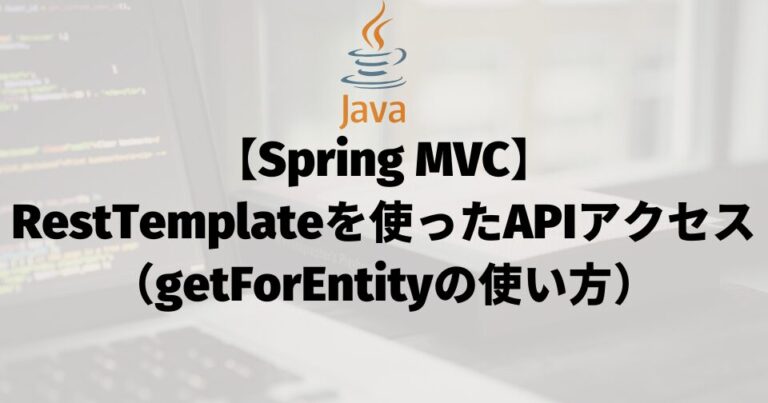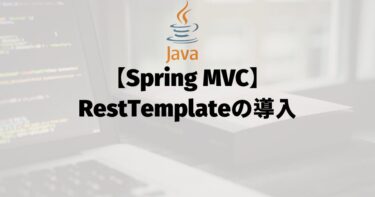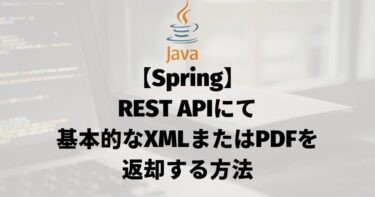概要
RestTemplate#getForEntityメソッドの基本的な使用方法についてまとめた。
動作確認を行うための事前準備については、以下に記載している。
概要 RESTfulなAPIを呼ぶクライアントライブラリである、RestTemplateの概要についてまとめた。 RestTemplateを使用するための準備と、どんなメソッドがあるのかを紹介している。 前提 今[…]
基本的な使い方
RestTemplate#getForEntityメソッドは、指定したURIにGET通信を行って、HTTPステータス/ヘッダー/ボディを含むResponseEntityオブジェクトを取得する。
メッセージコンバーターを内包するため、取得するレスポンスボディは指定した型(ジェネリクスを除く)にマッピングできる。
実装方法
RestTemplate#getForEntityメソッドは、基本的に以下のように実装する。
戻り値は指定したレスポンスの型をボディにもつResponseEntityとなる。
使用例
APIアクセスクラスにgetForEntityメソッドを追加し、動作確認を行う。
APIアクセスクラス
URIと任意のオブジェクトを指定して呼び出す。
RestClient.java
package com.example.client_prototype.biz;
import java.net.URI;
import org.springframework.beans.factory.annotation.Autowired;
import org.springframework.http.ResponseEntity;
import org.springframework.stereotype.Component;
import org.springframework.web.client.RestTemplate;
@Component
public class RestClient {
@Autowired
private RestTemplate restTemplate;
/**
* getForEntityの利用
* @param <T>
* @param uri
* @param responseType
* @return
*/
public <T> ResponseEntity<T> getJsonEntity(URI uri, Class<T> responseType) {
return restTemplate.getForEntity(uri, responseType);
}
}
取得したいレスポンスの型を引数で指定する。
ResponseEntityのボディに、取得したいレスポンスの型が格納されて返却される。
動作確認
戻り値を指定して動作確認を行う。
尚、以下のXMLを返却するREST APIアプリに疎通している。
動作確認用クラス
package com.example.client_prototype.executor;
import java.net.URI;
import org.springframework.context.support.ClassPathXmlApplicationContext;
import org.springframework.http.ResponseEntity;
import org.springframework.web.util.UriComponentsBuilder;
import com.example.client_prototype.biz.RestClient;
public class Main {
public static void main(String[] args) {
try (var context = new ClassPathXmlApplicationContext("/META-INF/spring/applicationContext.xml")) {
// DIコンテナから取得
var restClient = context.getBean(RestClient.class);
// URI定義
URI uri = UriComponentsBuilder
.fromUriString("http://localhost:8080/rest_prototype/rest08/xml")
.build()
.toUri();
// 動作確認
ResponseEntity<byte[]> resEntity = restClient.getJsonEntity(uri, byte[].class);
System.out.println(resEntity);
}
}
}
上記はXML情報をバイナリで取得している。
ResponseEntityを取得することで、HTTPステータス/ヘッダー/ボディの値を参照できる。
HTTPステータス
ResponseEntityからHTTPステータスを参照する。
動作確認用クラス
// ステータスコードを取得
HttpStatus status = resEntity.getStatusCode();
System.out.println(status); // 200 OK
上記でHTTPステータスを取得できる。
ヘッダー
ヘッダーを取得することで、コンテンツタイプやファイル名などを取得することができる。
動作確認用クラス
// ヘッダーを取得
HttpHeaders headers = resEntity.getHeaders();
// ヘッダーのContent-Dispositionからファイル名を取得
String contentDisposition = headers.getFirst(HttpHeaders.CONTENT_DISPOSITION);
String fileName = "";
List<NameValuePair> params = URLEncodedUtils.parse(contentDisposition, StandardCharsets.UTF_8);
for (NameValuePair param : params) {
if ("filename".equalsIgnoreCase(param.getName()) || "filename*".equalsIgnoreCase(param.getName())) {
// 余計なダブルクォートを削除して返す
fileName = param.getValue().replace("\"", "");
}
}
System.out.println(fileName); // XMLサンプル.xml
// ヘッダーのContent-typeを取得
MediaType contentType = headers.getContentType();
System.out.println(contentType); // application/xml
上記でorg.springframework.http.HttpHeadersオブジェクトを取得し、レスポンスヘッダーを参照できる。
ファイル名を取得するために使用しているURLEncodedUtilsまわりは、以下のライブラリを参照する必要がある。
pom.xml
<!-- URLEncodedUtilsを使用するためのライブラリ -->
<dependency>
<groupId>org.apache.httpcomponents</groupId>
<artifactId>httpclient</artifactId>
<version>4.5.13</version>
</dependency>
ボディ
レスポンスボディの値を取得する。
動作確認用クラス
// レスポンスボディ部を取得
byte[] xmlBody = resEntity.getBody();
System.out.println(new String(xmlBody));
上記により、引数で指定した型にてレスポンスボディを取得する。
まとめ
☑ getForEntityを使用することで、GETリクエストを送信してResponseEntityを取得することができる
☑ レスポンスボディは任意の型を指定できる
☑ ResponseEntityで取得することで、HTTPステータス/ヘッダー/ボディなどの情報を参照できる


